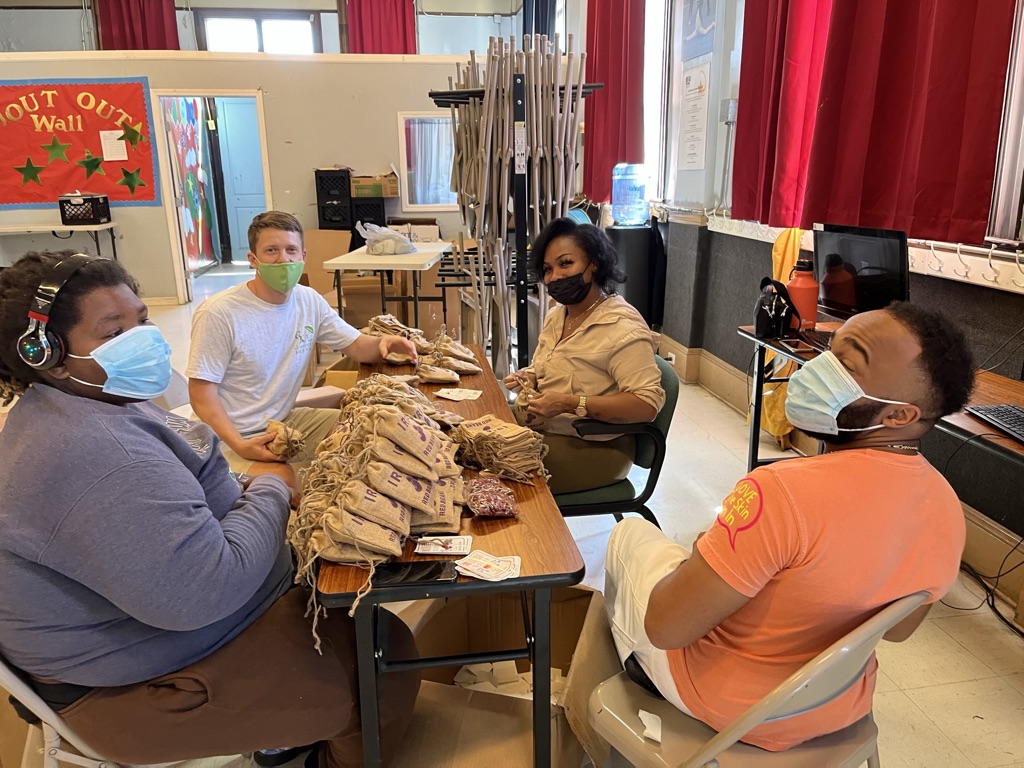Throw Me Something Sustainable, Mister
February 26, 2022
LSU graduate’s non-profit brings consumable, sustainable throws to parades and festivals
BATON ROUGE - LSU graduate Brett Davis (2013) hopes spectators at this year’s Mardi
Gras parades catch one of his sustainable throws. Davis is a New Orleans native who
grew up only blocks away from the Uptown parade route. After receiving his master’s
degree from LSU in landscape architecture in 2013, he stays busy through his business
that renovates historic New Orleans homes, and his non-profit called Grounds Krewe
that he hopes will bring positive change to the waste created by Mardi Gras.
What is Grounds Krewe?
Grounds Krewe is a 501(c)3 non-profit that is focused on providing waste prevention,
recycling and sustainable products for New Orleans festivals. The organization has
a strong focus on how to lower the waste impact of Carnival parades, which can produce
as much as 2.6 million pounds of street waste in just 11 days. Most of that waste
is unwanted, disposable, plastic beads made with really unhealthy materials in factories
overseas and items like cans and bottles that aren’t being recycled.

New Orleans native Brett Davis started a non-profit to improve waste prevention, recycling and sustainable products for New Orleans festivals.
– Credit: Brett Davis
Why did you become interested in changing or improving the throws for Mardi Gras?
I’ve always had a very strong interest in protecting the environment. I grew up hunting
and fishing in the woods and coastal marshes of Louisiana and spent several years
backpacking around the world discovering unique landscape phenomenon. When I came
back to New Orleans after my time at LSU, I settled into my design business which
was rewarding in some ways but not sufficiently answering the call of a myriad of
global environmental issues. Those issues can be really overwhelming and as one person,
it’s hard to feel that you have any ability to make an impact. I felt that way, so
I started thinking about what environmental problems were unique to my immediate surroundings
where there wasn’t much progress being made. I have experienced Mardi Gras parades
as both a spectator and rider since I was a kid and noticed how it had transformed
to the point that it was normal to be walking ankle deep in trash after most parades.
I realized most of the waste was unnecessary, no one was claiming responsibility for
it, and nothing was being done to prevent it.
Why are sustainable throws better?
Throws have become an inherent part of parades. They are the reason for float riders
and one of the attractions for spectators. Their sale also provides some of the revenue
a Krewe needs to conduct a parade. At some point though, a threshold was crossed where
the quantity of cheap throws being sold and tossed started to lower interest and vast
quantities were trashed soon after being caught or left ignored on the streets.
The problem is that these throws are made from the cheapest materials possible halfway around the world. Their journey here takes a lot of energy and resources, and it’s all for something that is likely to be discarded right after being thrown. It’s bad enough that most throws go straight to the landfill through the trash, but many also end up in storm drains, where they leach out chemicals and then make their way into local waterways as micro-plastics.
Grounds Krewe’s sustainable throws are recycled, biodegradable, functional, consumable, and locally sourced. Their expected “end of life” is completely different than a plastic bead and other imported goods. They also help foster a “local throw economy” which builds value into throws by having their production and sale benefit local businesses, organizations and labor forces.

Davis and volunteers bag sustainable throws to be used by the Krewe of Iris for their 2022 parade.
– Credit: Brett Davis
Where do you get the sustainable throws?
The throws come from a variety of places. Our most popular items are the consumable
throws, which come from local companies like Camellia Red Beans, Jambalaya Girl and
coffee from New Orleans Roast. We buy custom-sized, blank product bags from them and
then pay local labor forces to sticker and stuff them into cute, hand woven jute fiber
baggies from India.
The Palm Tree “Seed Beads” come from a women’s co-operative in Belize I was introduced to by a local supporter. The recycled plastic cups come from a company in Massachusetts giving waste products new life, and they are printed here in NOLA. We have soap from an artisan in Port Allen we found through the internet and commissioned to make a Mardi Gras-colored bar with biodegradable glitter. Every throw has a great story!
Why did you want to include local businesses?
We are trying to build value into our throws that goes beyond just environmental benefits.
We appreciate how challenging it is to be cost competitive with disposable plastic
goods from China, so we are adding in layers of other benefits to justify their price.
The goal is to foster a “local throw economy,” where we buy local products and pay
wages to those in need of basic skilled jobs to assemble throws. Instead of spending
millions of dollars overseas each year on items that have little value, we want to
spend that money here and benefit the local community. Our non-profit status allows
us to subsidize the cost of those throws, to an extent, so that grants and philanthropic
sources that want to support this cause of replacing foreign products with local,
sustainable ones can help do so.
Where can people catch some of these sustainable throws?
Grounds Krewe designed and produced its first ever krewe-branded package of sustainable
throws for the Krewe of Iris this year. One thousand packages of 106 of our throws
will be tossed for February 2022. We also continue to sell to riders in any parade
through our online catalog, so you will see them at other parades as well. The family-friendly
day parades are our biggest customers!
This is an idea that is very unique to New Orleans and Louisiana, but what kind of
larger impact do you hope for?
I want people everywhere to understand that there is no such thing as "away." When
you throw something "away” or leave it on the street, it still has to go somewhere.
That’s easy to forget when landfills operate largely out-of-sight, out-of-mind. Whether
the final destination is a municipal dump, recycling center, second-hand store, drainage
system or local watershed, everything we use will eventually end up somewhere else
to start an incredibly long process of degradation. That knowledge should stay with
people when they are out at parades and festivals. It should inform what they perceive
as normal or acceptable and what can evolve to be better, so that we end up with celebrations
we can all feel proud of.
What goals to do you have for Grounds Krewe?
There is A LOT of work to do. We are trying to get at this problem from all the usual
avenues: awareness, education, free market, policy, etc. The big idea is to get people
to acknowledge who is responsible for the waste and then through proof-of-concept,
show them all the ways that krewes, riders, the city and spectators can do better.
We want every parade in the city to start moving away from imported, disposable plastic throws towards more eco-friendly options. We want the city to team up with us to implement practical waste prevention and recycling opportunities out on the parade route. We want to create a compostable bead made from local waste products. We want to help steer millions of dollars spent each year on foreign throws back towards our economy.
How can others get involved?
There are many ways to help support our work. Just acknowledging and talking about
the issue is helpful and of course donating to the non-profit, shopping the Sustainable
Throw Catalog and volunteering with our initiatives is always welcome.


